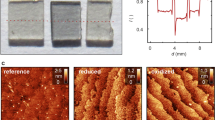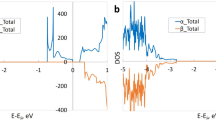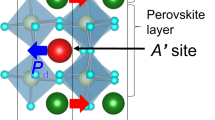Abstract
THE interaction of domain and defect structures in ferroelectrics and, in particular, in triglycine sulphate (TGS) accounts for many important properties of this class of crystal. An example is the restoring of the domain structure after repolarization processes (the “memory” of crystals) associated with the real structure of crystals. The domain structure of TGS, which has been studied by etching1,2, electroluminescence3 and the charged powder technique4, has been related to only one kind of structure defect, however—dislocations5,6—and it has been stated that there is no correlation between domains and dislocations.
This is a preview of subscription content, access via your institution
Access options
Subscribe to this journal
Receive 51 print issues and online access
$199.00 per year
only $3.90 per issue
Buy this article
- Purchase on Springer Link
- Instant access to full article PDF
Prices may be subject to local taxes which are calculated during checkout
Similar content being viewed by others
References
Konstantinova, V. P., Kristallographiya, 7, 748 (1962).
Sawada, A., and Abe, R., Japan J. Appl. Phys., 6, 699 (1967).
Zheludev, I. S., Filimonov, A. A., Yurin, V. A., and Romanyuk, N. A., Kristallographiya, 6, 676 (1961).
Pearson, C. L., and Feldman, W. L., J. Phys. Chem. Solids, 9, 28 (1958).
Taurel, L., and Gilletta, F., Proc. Intern. Meeting Ferroelectricity, Prague, 1966, 2, 43.
Klassen-Neklyudova, M. V., Mechanical Twinning of Crystals, 184 (Consultants Bureau, New York, 1964).
Bassett, G. A., Phil. Mag., 3, 1042 (1958).
Distler, G. I., Kobzareva, S. A., and Gerasimov, Y. M., J. Cryst. Growth (in the press).
Distler, G. I., Second Colloquium on Thin Films, Budapest, 1967 (in the press).
Takagi, M., Suzuki, S., and Tanaka, K., J. Phys. Soc. Japan, 23, 134 (1967).
Toyoda, H., Tanaka, I., and Shikawa, W., Rev. Elect. Commun. Lab., 9, 485 (1961).
Distler, G. I., Kobzareva, S. A., and Chudakov, V. S., Phys. Stat. Sol. (in the press).
Coutts, M. D., and Revesz, A. G., J. Appl. Phys., 37, 3280 (1966).
Konstantinova, V. P., in Growth of Crystals, 8 (Nauka, Moscow, 1967) (in Russian).
Moravets, F., and Konstantinova, V. P., Kristallographiya (in the press).
Distler, G. I., in Growth of Crystals, 8 (Nauka, Moscow, 1967).
Distler, G. I., and Zvyagin, B. B., Nature, 212, 807 (1966).
Author information
Authors and Affiliations
Rights and permissions
About this article
Cite this article
DISTLER, G., KONSTANTINOVA, V., GERASIMOV, Y. et al. Interaction of Defect and Domain Structures of Triglycine Sulphate Crystals in Ferroelectric and Paraelectric States. Nature 218, 762–765 (1968). https://doi.org/10.1038/218762a0
Received:
Issue Date:
DOI: https://doi.org/10.1038/218762a0
Comments
By submitting a comment you agree to abide by our Terms and Community Guidelines. If you find something abusive or that does not comply with our terms or guidelines please flag it as inappropriate.



